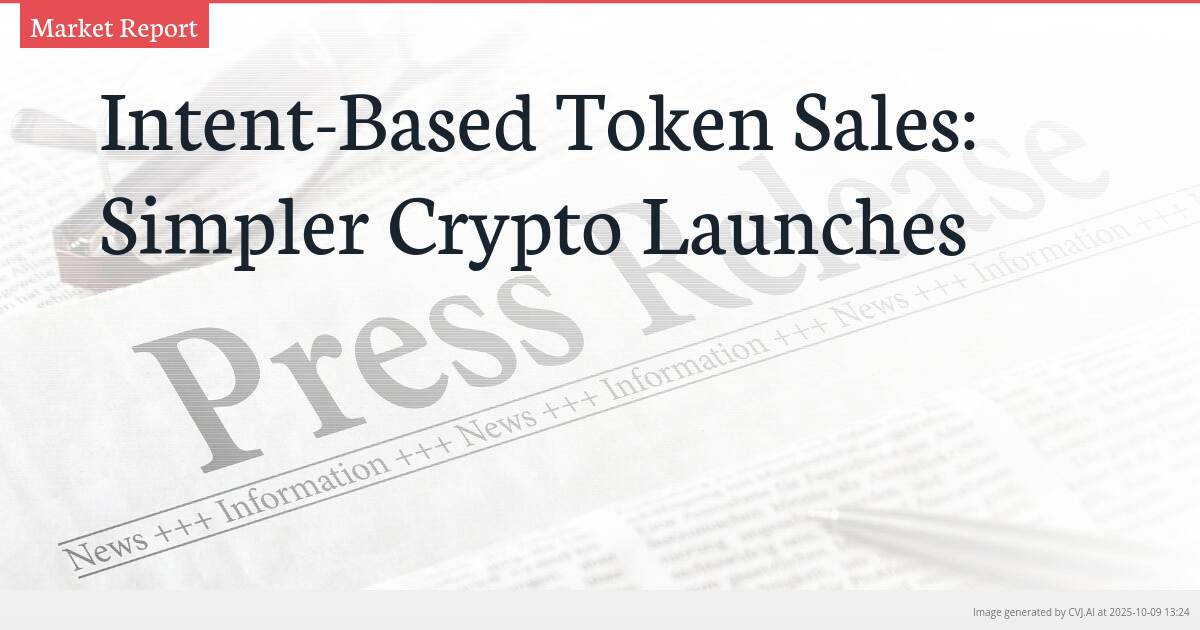This summary text is fully AI-generated and may therefore contain errors or be incomplete.
Introduction
Token sales have long represented both the promise and peril of cryptocurrency investing—offering early access to groundbreaking projects while demanding navigation of complex, multi-chain processes fraught with risk. Now, intent-based architecture is poised to revolutionize this landscape, reducing participation to a single click and eliminating the technical hurdles that have long frustrated investors. This transformation, exemplified by platforms like Calyx and technologies such as NEAR Protocol’s Intents framework, promises to make token launches more accessible, secure, and efficient across multiple blockchains.
Key Points
- Intent-based architecture simplifies multi-chain token sales to single-click participation using existing holdings
- Calyx launchpad leverages NEAR Intents to enable projects to launch tokens across 20+ blockchains simultaneously without bridges
- Intellex protocol uses the same chain abstraction technology for its cross-chain agent collaboration framework and token sale
The Problem With Traditional Token Sales
Traditional token sales present a paradox in the crypto space: while offering potentially lucrative early exposure to promising projects, they simultaneously impose significant operational complexity and risk. The current multi-stage process requires investors to navigate token swapping, bridging between networks, and managing multiple wallets—all while interacting with unfamiliar smart contracts and blockchain environments. This complexity is compounded by intense competition for allocations, with many investors going through the entire arduous process only to be rejected due to oversubscription.
The risks extend beyond mere inconvenience. Each interaction with unfamiliar networks amplifies the potential for costly errors, from misconfigured transactions to failed bridge operations. The administrative burden becomes particularly pronounced when investors must purchase tokens on one network and claim new tokens on another—a common requirement that introduces multiple points of failure. Despite these challenges, the potential rewards have kept investors engaged in a system that many acknowledge is fundamentally flawed and inefficient.
How Intent-Based Architecture Solves Complexity
Intent-based architecture represents a paradigm shift in how users interact with blockchain networks, particularly for complex multi-chain operations like token sales. Rather than requiring users to manually execute each step of a multi-chain transaction, intent-based systems allow users to simply declare their desired outcome—such as ‘participate in this token sale using my USDC on Solana’—while specialized solvers handle the technical implementation across chains. NEAR Protocol’s Intents framework exemplifies this approach, utilizing chain signatures and solver networks to create seamless cross-chain experiences.
The practical benefits are substantial. Users can participate in token sales using assets they already hold on any supported network—whether that’s USDC on Solana, ETH on Ethereum, or other major cryptocurrencies. The smart contract handles the complexity automatically: if an allocation is secured, the locked funds are retained and the new token becomes claimable on the appropriate network; if unsuccessful, funds are returned automatically. This reduces what was previously a multi-hour, multi-step process to a couple of clicks while eliminating the risk of user error during complex cross-chain operations.
For developers, intent-based architecture offers equally significant advantages. Rather than coding and auditing complex cross-chain smart contracts from scratch, developers can leverage existing tooling and libraries that come bundled with frameworks like NEAR Intents. This accelerates development timelines while enhancing security through proven, audited components that handle the most complex aspects of cross-chain interoperability.
Intellex and Calyx: Intent-Based Launches in Action
The real-world application of intent-based token sales is already demonstrating tangible benefits through platforms like Calyx and projects like Intellex. Calyx serves as an omnichain token launchpad that enables projects to reach users across more than 20 blockchains simultaneously—without requiring bridges or complex custom smart contract development. By leveraging NEAR Intents, Calyx simplifies cross-chain interactions, giving users equal access regardless of their preferred network.
Intellex’s recent $ITLX token sale on Calyx provides a compelling case study. The project, which is building a framework for cross-chain agent collaboration with a ‘collective memory’ system for enterprises and individuals, utilized the same intent-based technology for both its token sale and its core protocol functionality. The Intellex protocol operates as a Layer 2 solution that uses chain abstraction technology to enable agents to own, share, and use collective memory across multiple networks—demonstrating how intent-based architecture benefits both token distribution and underlying protocol functionality.
The integration between Intellex and Calyx highlights how intent-based systems are creating new possibilities for blockchain interoperability. Rather than treating cross-chain functionality as an afterthought, these technologies make seamless multi-chain operation a foundational feature. For token sales specifically, this means projects can launch simultaneously across Ethereum, Solana, NEAR, and numerous other networks while maintaining consistent user experience and security standards.
The Future of Cross-Chain Token Distribution
As blockchain projects increasingly recognize the limitations of single-chain approaches, intent-based architecture offers a practical path toward true interoperability. The technology effectively serves as a shortcut to achieving the blockchain industry’s long-standing goal of seamless cross-chain operation—what many consider the ‘endgame’ where blockchain fragmentation is entirely eliminated. By making all blockchains work as one cohesive system, intent-based systems could fundamentally reshape how users interact with decentralized applications.
The implications extend far beyond token sales. The same technology that simplifies cross-chain launches can be applied to decentralized exchanges, lending protocols, and any application requiring multi-chain functionality. As demonstrated by Intellex’s use of NEAR Intents for both its token sale and its agent collaboration framework, the technology provides foundational infrastructure that benefits multiple aspects of the Web3 ecosystem.
While still in early adoption phases, intent-based token sales represent a significant evolution in how cryptocurrency projects reach investors and how users participate in new opportunities. By reducing complexity, minimizing risk, and expanding accessibility across multiple networks, this approach addresses many of the fundamental pain points that have limited broader participation in token sales. As more projects follow Intellex’s example and platforms like Calyx continue to mature, intent-based architecture may soon become the standard for token distribution—finally delivering on blockchain’s promise of borderless, frictionless financial participation.
📎 Read the original article on co.uk

